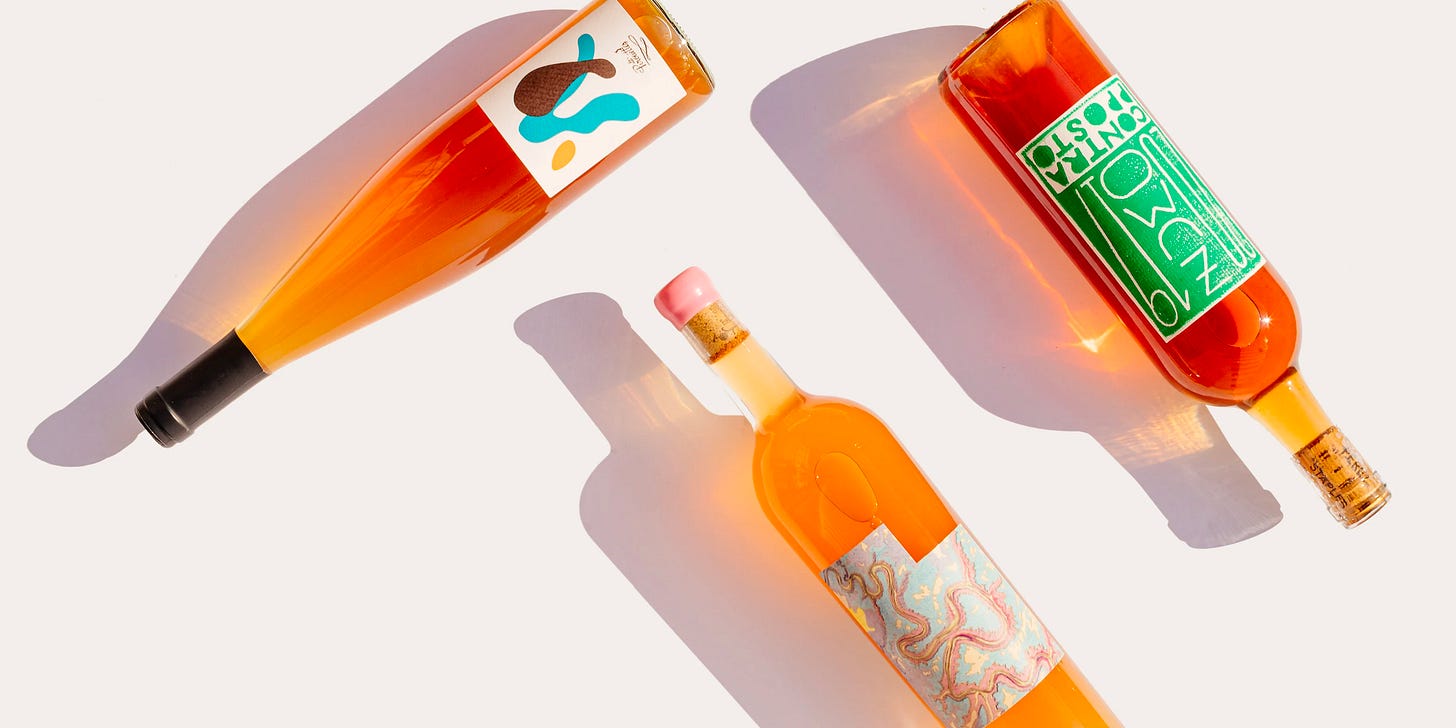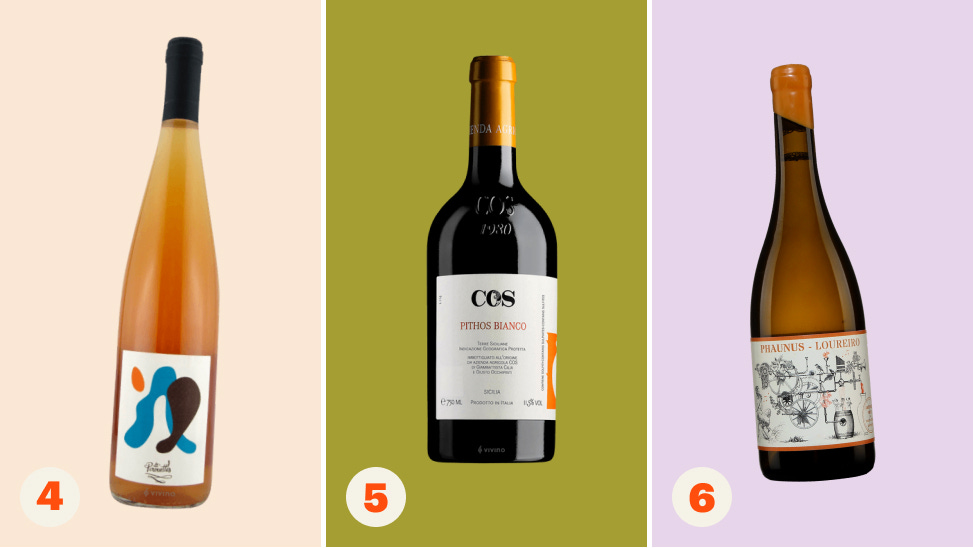Breaking down the orange wine trend + 6 bottles to try
🍊 There is way more variety to orange wine than you might think
What is Orange wine?
As a refresher, red wine is made by picking red grapes (like Cabernet or Sangiovese) and letting them sit in contact with their skins to ferment before pressing the juice. White wine is made similarly but without any skin contact during fermentation. Orange wine is almost a hybrid. It’s made by taking white grapes and letting them ferment with the skins for a period of time, could be a day, a week, or sometimes even years before pressing, giving it the golden, amber color and the common moniker of “skin contact” wine. Simply put, you can think of orange wines as white wines made like red wines. Technically, red, rosé and orange wines are all “skin contact” wines.
Sidebar: what is rosé, you ask? That is an article for another day but the most common style of rosé is made by taking red grapes and letting it sit with the skins just long enough to give a touch of pink color. These are much faster on average to produce than Orange wines.
Orange wines are made using a natural process with little to no additives. This often creates a slightly sour and nutty quality to the wine from the oxidation. It is easy to think that all orange wines are similar — especially since most restaurants and bottle shops typically carry a quite limited selection from this category. But orange wines are quite diverse, both from the grapes that are used and the style of the final product. You can find pretty, floral orange wines, or tropical orange wines, “funky” wines reminiscent of a sour-beer or kombucha, and even bold, tannic wines that drink more like a red.
Quick history lesson
Though Orange wine is incredibly trendy now, it is actually one of the oldest styles of wine production, dating back thousands of years to what is present day Georgia. This technique was developed by Assyrian monks to preserve and protect the wine before we had electricity or refrigeration. Grapes were crushed — skin, stems, and all — and loaded into giant, egg shaped clay pots called qvevri and buried for 5-6 months to ferment.
This style began to see a resurgence more recently as winemakers embraced more cultural and historical styles of wine rejection — likely the result of large scale commercialization and standardization of wine in the 80’s and 90’s. Today, orange wine is produced in Italy, Slovenia, Croatia, France, Austria, the United States….basically anywhere producing wine has some form of orange wine. Each country and region has its own approach to making orange wine, resulting in unique flavors and styles.
Georgia: often tannic and structured, with flavors of dried fruits, nuts, and honey.
Italy: lighter and less tannic than Georgian orange wines, with flavors of stone fruit, citrus, and herbs. Look for the label “Ramato,” which means “auburn,” and typically refers to Italian Pinot Grigio made in an orange wine style in the northeastern regions of Friuli-Venezia Giulia and Veneto.
Slovenia: typically more "rustic" and "earthy", with flavors of apricot, honey, and spice.
Croatia: known for their complexity and richness, with flavors of dried fruits, flowers, and herbs.
France: tend to be more delicate and floral than other orange wines, with flavors of nuts, herbs, and stone fruits. Orange wine production in France is still relatively new, and is mainly centered in the Jura region.
If you are looking for an intro to Orange wine, you might start with a paler wine with less skin contact time. But if you’re looking for something bold and unique, dive right into the darker, amber hues!
Enough talk, let’s get drinking
Here are a few bottles I like, starting with the lighter, entry level wines with less skin contact. I would say all of these are fairly approachable though so don’t be intimidated by those at the end of the list. If you can’t find these, your local wine shop should be able to help you fine something similar.
1. Azimut Brisat
👩🌾 Azimut
🏷 Brisat
🇪🇸 Penedès, Spain
🍇 Parellada, Sumoll Blanc, Garnatxa Blanca, Moscatell
💵 $19
⏰ 5 days skin contact
In Catalunya, the term Brisat refers to white wines that are produced in contact with the “brisa” or, the skins, stems, and seeds of the grapes. This is actually a regulated term meaning any wines you see labeled “Brisat” will be from the same region (DO Terra Alta) with a similar style.
Refreshing and easy-drinking wine that pairs well with seafood, salads, and light appetizers. Fresh and aromatic, with notes of citrus, white flowers, green apple, and a hint of minerality. Light-bodied and crisp, with a subtle nuttiness. Small but noticeable hit of funky goodness. Super approachable.
2. Meinklang Mulatschak Weisser
👩🌾 Meinklang
🏷 Brisat
🇦🇹 Burgenland, Austria
🍇 Gewurztraminer, Pinot Gris, Welschriesling
💵 $19
⏰ 7 days skin contact
Fresh and aromatic, with notes of citrus fruits, green apple, and a hint of floral sweetness. There is a subtle minerality and a balanced acidity that keeps the wine bright and crisp.
3. OKR Milan Nestarec
👩🌾 OKR
🏷 Milan Nestarec
🇨🇿 Moravia, Czech Republic
🍇 Chardonnay, Grüner Veltliner, Sauvignon Blanc
💵 $34 (Liter)
⏰ 7 days skin contact
Gently aromatic, crisp, zesty, earthy, and citrus forward. Herbaceous with notes of grapefruit, passionfruit, and apricot. Medium acidity and a long, mineral finish. Zingy, fresh and too easy to get through the liter! Pairs well with spicy dishes, roasted meats, and aged cheeses.
4. Les Vins Pirouettes Eros
👩🌾 Les Vins Pirouettes
🏷 Eros
🇫🇷 Alsace, France
🍇 40% Pinot Gris, 40% Riesling, 20% Sylvaner
💵 $24
⏰ 25 days skin contact
Lovely aromas of citrus, baked apples, and spice, with notes of tropical fruit and chamomile. This wine has a deep orange in color and intensely fragrant of spicy bitter orange (almost like an Italian chinotto soda!)
5. COS Pithos Bianco
👩🌾 COS
🏷 Pithos Bianco
🇮🇹 Sicily, Italy
🍇 Garganega (Grecanico in Italian)
💵 $35
⏰ 1 month skin contact
Distinctive and rustic, aged in clay amphorae giving the wine a unique earthy quality. Hints of orange blossom, peach, and apricot. With some more savory, herbal notes, such as thyme and sage, and a subtle nuttiness. This wine is richer and more textured than others I have listed, with a full body and a slightly tannic structure. It has flavors of ripe citrus fruits, such as lemon and grapefruit, and a subtle nuttiness. It has a deep golden color, with a slightly cloudy appearance due to the unfiltered winemaking process. Pairs well with seafood, such as grilled prawns or scallops.
6. Aphros Phaunus Loureiro
👩🌾 Aphros
🏷 Phaunus Loureiro
🇵🇹 Minho, Portugal
🍇 Loureiro
💵 $25
⏰ 6 months skin contact
Really fun and unique wine aged in beeswax-lined amphora in a winery without electricity. Pale hazy gold, with lots of smoke and an almost spicy quality. The least “beginner” orange bottle on my list but it is fantastic with a floral, lemony, grassy, and energetic profile.












i'm a repeat purchase of the eros and that meinklang. such easy drinking!